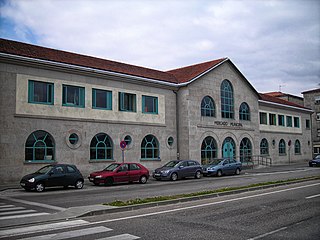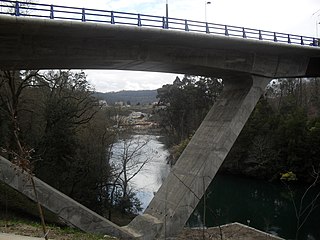
Pontevedra is a city in the autonomous community of Galicia, in northwestern Spain. It is the capital of both the Comarca and Province of Pontevedra, and the capital of the Rías Baixas. It is also the capital of its own municipality which is often considered an extension of the actual city.

Fires in Galicia are caused by deforestation and brush clearing, the removal of indigenous fauna, and arsonists. The fires have been occurring since the mid-1990s. Fires in Galicia represent 50% of the area burned each year in Spain and 40% of all fires.

The Burgo Bridge(Puente del Burgo) is a medieval bridge, built over an older bridge of Roman origin, which crosses the Lérez River in the city of Pontevedra, Spain. It is on the route of the Portuguese Way to the north of the historic centre of Pontevedra and to the south of the Burgo neighbourhood. Between the arches above the pillars are carved the famous stone pilgrim's shells.

The Covo Island, better known as the Island of Sculptures or Illa das Esculturas in Galician, is a park and island located near the mouth of the Lérez River, in Pontevedra, Spain. It has an area of 70,000 m² and is connected to both banks of the river by footbridges and pedestrian bridges. It is the largest and most important open-air museum in Galicia and one of the most important in Spain.

The Palm Trees Park, also known simply as Las Palmeras, is a public park in the heart of Pontevedra in Spain. It is the most representative and emblematic green area in the city centre, together with the Alameda de Pontevedra.

The Lérez beach is a Galician beach located in the municipality of Pontevedra in the province of Pontevedra, Spain. It is a semi-urban river beach with a length of 100 metres.

The Pontevedra campus is one of three campuses that host the University of Vigo. It is located in the Spanish city of Pontevedra and offers undergraduate, postgraduate and doctoral studies in Social sciences, health sciences, arts, engineering and Sports.

The Convent of St. Clare is a former cloistered convent of the Order of Poor Clares, located in the city centre of Pontevedra, Spain, precisely in Santa Clara Street, near the disappeared St. Clare Gate of the medieval city walls. Founded in 1271, the convent closed in 2017. In 2021 the City Council bought the building from the Order, and in 2023 it transferred it to the Provincial Deputation to become part of the Pontevedra Museum.

The Natural Park of the Marismas de Alba, the Alba Marsh or the Xunqueira de Alba, is a natural park and wetland in the city of Pontevedra in Spain, and one of the few Marshes in the Ria de Pontevedra. It is a park used as a place for walking, cycling and observing the fauna and flora.

Monte Porreiro is a residential area in the city of Pontevedra (Spain). It is the seat of the National University of Distance Education in the province of Pontevedra. The neighbourhood has a health centre, a school and a high school and a parish church since the end of the 20th century, its patron saint being the Good Shepherd. There are also green areas, the most important being the Belvedere Park.

The Palace of Lourizán is a manor house in Herbalonga in the civil parish of Lourizán, in Pontevedra, Spain.

The Botanical Garden of Lourizán is an arboretum of some 54 hectares in the municipality of Pontevedra in Spain. It has more than 850 catalogued species and one of the largest collections in Spain. It is the most important botanical garden in Galicia.

The Central Market of Pontevedra is a covered market located in Pontevedra, Spain. It is located at the north-eastern edge of the historic centre, close to the Burgo Bridge. It overlooks the banks of the Lérez river and was inaugurated in 1948.

The paseo marítimo of Pontevedra is a pedestrian way along the seafront facing the ria of Pontevedra, in Pontevedra, Spain. This coastal public space is built in the urban and semi-urban area of the city and defines its encounter with the sea and the Lérez river.

O Burgo is a neighbourhood in the city of Pontevedra (Spain). It is one of the oldest neighbourhoods in the city and is crossed by the Portuguese Way. On its right-hand side is the A Xunqueira area with important educational and cultural facilities.

The UNED Associated Centre in Pontevedra is a university teaching centre of the National University of Distance Education (UNED) located in the Spanish city of Pontevedra. It is part of UNED's North-West Campus and is its most important centre.

The Plaza de Barcelos is a square dating from the beginning of the 20th century located in the city centre of Pontevedra (Spain), to the east of the historic centre of Pontevedra.

The Santiago Bridge crosses the Lérez River in the city of Pontevedra (Spain), where the N-550 road runs alongside it. It connects the city centre with the A Xunqueira area and the O Burgo district.

The Word Bridge is a delta-leg bridge that crosses the Lérez River in the Monte Porreiro district of the city of Pontevedra (Spain). It was inaugurated in 2011 and connects the Monte Porreiro neighbourhood with the civil parish of Lérez.

The Forest Engineering School of Pontevedra is a engineering school of the University of Vigo founded in 1990 in Pontevedra, Spain, and based at the A Xunqueira campus.





























